Readers, get ready! For transportation vehicle lovers and beyond, this book has something for everyone. Through rhyme and bold illustrations, readers will gasp as a truck hauling a massive twenty-ton load slides in the mud and blocks passage through a narrow island road. Travelers on both sides of the truck are desperate to get to their intended destinations. Trust, friendship, and creative problem solving save the day in this fascinating story based on a real community in Maine. All is well as travelers reach their locations in time, the truck gets back on the road, and the surprising and delightful load is revealed. Readers will agree this book is going to be a favorite for the long haul.
You are here
A Baker's Dozen: The Best Children's Books for Family Literacy

Big Truck Little Island
Tips for Using with Children
After showing the cover of the book, turn to the title page. Point out the tugboat pulling the barge with a large truck on it with a covered load strapped down. Read the title and the name of the author/illustrator. The title makes us think that they are going to an island. Read the first page of the story that tells that the barge is taking the big truck to an island. Turn the page and show the picture of the island—land surrounded by water. The tugboat is approaching the island in the picture. Continue reading what happens in the story, pointing out the details and the action depicted in the double-page illustrated spreads.
Tips for Using with Families
Explain to families that with very young children, the text may be too long for their attention spans, so consider discussing the detailed pictures with them instead. Encourage adults to preread the text to add to their children’s understanding and descriptions. When reviewing the aerial image of the island, trace the path along the road that the truck must follow. Use this page as a reference on and off during the story. Younger children can respond with their own story ideas of what they think is happening in the pictures. For example, emphasize pictures with a four-year-old and content with older children.
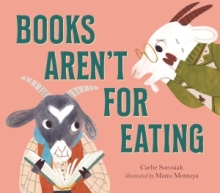
Books Aren’t for Eating
In this delightful book, readers are introduced to Leopold the goat, owner of a cozy bookstore with lots of character. Leopold loves books, and especially enjoys selecting just the right book for each customer. He is faced with a challenge when a fellow goat enters the bookstore. This goat’s instinct is to eat books, rather than read them. Leopold is understanding, as he once reacted the same way, until he realized that books held the potential to transport him to imaginary lands. With the loveable charm found in his bookstore, Leopold matches his customer with a familiar book that satisfies his appetite… for reading, that is!
Tips for Using with Children
During circle time, ask children to share a favorite book. There are so many different kinds of books to enjoy.
Tips for Using with Families
Leopold likes to find books that match readers’ interests. Ask adults to list the topics and interests their child likes best. Provide a selection of children’s books for the adults to browse and ask each to select one (or more!) and describe how the characteristics of the book match the interests of their child. Sometimes it takes just the right book for a child to develop into a reader.
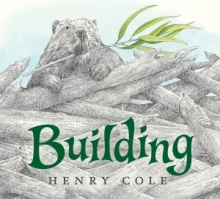
Building
Building, building, that is what beavers do best. Through limited use of color and intricate detail, this true-to-nature story follows two beavers as they set out to build a home. These talented engineers use their teeth to gnaw the logs, create a dam, and build a lodge, providing a safe and warm home for their growing family as they explore the world around them. An author’s note at the end of the book highlights the natural skills beavers have as builders. This quiet, yet intricate book will prompt even the busiest beavers to pause, observe and wonder.
Tips for Using with Children
Children can become engineers by creating a beaver habitat of their own. Provide leaves, sticks, water, and mud or clay in a tray or low bin so that children can explore the materials and experiment to see what combinations work best to construct miniature beaver dams. Discuss what worked well and what did not. Foster curiosity by asking children what else they wonder about beavers that may not have been explored in the book, and research together using additional non-fiction texts or through an online search (e.g., National Geographic Kids).
Tips for Using with Families
The author’s note in the back of this book offers insights into the beaver’s role as an engineer, detailing how they can change their habitat to meet their needs. Children may have quite a few questions as they read this story, and previewing the facts prior to reading will help adults answer their questions and provide additional interesting facts. Consider providing additional nonfiction books for adults to peruse.
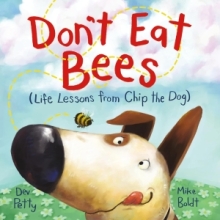
Don’t Eat Bees (Life Lessons from Chip the Dog)
Chip is a dog who has been around the block enough times in his seven years to have acquired some worldly wisdom to share. For example, when it comes to burying bones, one can dig a large hole and put thirty bones in it or dig thirty holes and put one bone in each. Chip generously shares more advice with the reader regarding cats, other dogs, bones, and most importantly, what to eat and what not to eat. Chip provides rave reviews for menu items such as socks, important papers, plants, and the couch; however, under no circumstances should the reader, or anyone else for that matter, consider eating bees. To find out if Chip practices what he preaches, don’t eat bees… but DO read this book!
Tips for Using with Children
Create a written chart of Chip’s dos and don’ts. Ask children what they think Chip’s humans think about this list. Would they agree or disagree? How might they feel about each item on the list? Are there times they might feel frustrated, like when Chip eats socks? Are there other times when it might be funny, like when Chip borrowed Grandpa’s teeth?
Tips for Using with Families
Adults can talk with children prior to reading this book and share with children some of their life lessons. It could be anything from the importance of sharing to looking both ways before crossing the street. Adults can pause during Chip’s list of dos and don’ts to enjoy Chip’s antics and ask questions that assist children with understanding. For example, children may appreciate time to talk about what “important papers” Chip is encouraging others to eat. After finishing the book, ask children to share their favorite pieces of advice from Chip.
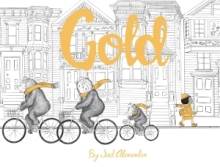
Gold
In this wordless, creative twist on Goldilocks and the Three Bears, the use of the color gold draws the reader’s eye to a little girl in the city who is riding the bus home from school on a blustery day. When she arrives home, she prepares something yummy and warm in a large pot. Three bears in golden scarves return home from a bicycle ride and follow the scent to three bowls of goodness waiting for them. As the reader soaks in the illustrations, they will see a lifetime of memories and love through the family portraits hanging on the walls of the home. When it comes to a new take on a classic tale, this book got it just right.
Tips for Using with Children
Children will enjoy taking the lead in narrating this story. Adults can point out the use of the color gold on each page and encourage children to follow it through the story. Does this remind you of another story? What other similar stories do you know? Provide other versions of Goldilocks.
Tips for Using with Families
Adults can revisit the original version of this fairy tale and compare the two stories. What parts are similar, and which are different? This book also presents an opportunity to talk with children about what makes a “family.” In a family, members help each other, extend kindness, count on each other, and show love and caring. Because there is no text to accompany the illustrations in this story, adults can empower children to guide the reading and describe what they see on each page. This approach provides insight on how children interpret the illustrations.
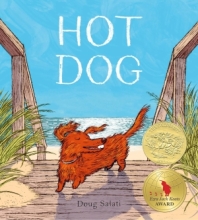
Hot Dog
This 2023 Caldecott winning book begins with summer in the city, a dog and its person head out to take care of a few errands. After a while, however, the hustle and bustle of the city along with the rising temperature cause the dog to feel overheated and overwhelmed. Perceptive and kind, the owner finds a way to escape an environment that is too loud, too close, and too hot. They whisk away by taxi, train, and ferry to find peace, recharge, and cool down by the sea. As the little dog frolics in the sand and sea and cools down, this book is sure to warm readers’ hearts.
Tips for Using with Children
Look at the cover and talk about the significance of the title Hot Dog. If children don’t mention it, the reader can share that dachshunds, because of their long shape, are often called “hot dogs” or a “wiener dogs.” This book has few words with much of the story told in pictures. The reader will want to bring the children’s attention to the dog and owner’s expressions as they make their way across the hot city streets, and finally find relief at the beach.
Tips for Using with Families
This is a great story for letting the children share in the narration. If needed, help steer their attention not just to the happenings in the pictures but also to the feelings depicted. Read expressively, altering tones and pace—louder for bold print words, slower as everyone cools down.
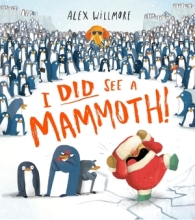
I Did See a Mammoth!
As part of a group on an expedition to look for penguins in the Antarctic, this book’s main character is instead bundled up and eager to spot the legendary woolly mammoth. Although these ancient relatives of elephants are believed to be extinct (as shared in a facts page at the end of the story), readers will share the excitement when a tutu-wearing, skateboarding mammoth enters the picture. Young readers will enjoy chiming in the repetitive shout of “Mammoth!” and the earnest pleas of the young child to the adults in the group, insisting that there are indeed more than penguins on this icy terrain. The detailed illustrations offer engaging talking points, and the humorous reactions of the offended penguins, upset that the main character is more interested in mammoths, add an amusing touch. The unexpected twist at the end will assure readers that this young explorer was telling the truth and was not just crying “mammoth.”
Tips for Using with Children
Before reading, obtain photographs of elephants and wooly mammoths. Show children pictures of each of them comparing their similarities and differences. Tell children that woolly mammoths are ancient relatives of today’s elephants. Introduce the term "extinction," clarifying that it means no longer in existence, and use dinosaurs as an example of animals that are extinct. This introduction to the story provides the children with prior knowledge to enjoy this humorous story even more. In another reading of the story, children can spend time looking at the double-page spreads with the hundreds of penguins and search for other fantastical happenings. For example, the penguins with fishing poles, the penguins making snowmen and so on. The book would lend itself well to a game of “I Spy.”
Tips for Using with Families
Humorous stories are always a joy for children to listen to—this silly book about a skateboarding mammoth is just such a book. There is built-in suspense. The suspense is enhanced by dramatic pauses and using your voice to exaggerate the excitement, for example when a mammoth appears! A funny story like I Did See a Mammoth will help children develop positive feelings about books and pleasure reading.
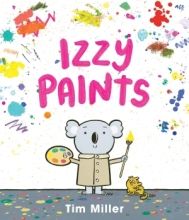
Izzy Paints
Readers embark on a creative journey with Izzy the koala and a cat as they explore the big city. Environmental print abounds throughout the book, providing many opportunities to pause and talk about the illustrations on each page. Other characters within the story appear in muted blue tones, so it is easy to spot Izzy and the cat as they navigate the city. Once in the art museum, Izzy not only sees the art, but feels it and even hears it speak. Drawing inspiration from the visit to the museum and from the surroundings, Izzy creates a masterpiece by painting big, small, gentle, and wild. When the bright, vivid and vibrant painting is placed on display for others to enjoy, it will also ignite the budding artistry within the readers.
Tips for Using with Children
During a second reading of Izzy’s artistic journey, guide children in identifying the vibrant colors. Encourage discussion about their favorite colors and those that make them feel happy. Izzy’s favorite color is yellow. Izzy starts painting the canvas with yellow and then adds other colors creating the image. After the story, give each child a large piece of paper to paint with their favorite colors. Emphasize how Izzy uses the brush to make big, gentle, and small strokes. Like Izzy, make sure that each child has a painting smock, brushes, paints, and a sturdy painting surface. Invite the children to share their creations with their families.
Tips for Using with Families
Encourage families to use Izzy Paints as a springboard for noticing color and artistic creations in children’s everyday environments. The book lends itself well to a game of “I Spy” with artistic terms from the book. Discuss with children special words to describe color, like saying "jade" instead of just "green." When talking with children about their art ask them to describe their creation. What did they enjoy the most about creating their art? Where would they like to display their art? What would they like to make the next time they paint or color?
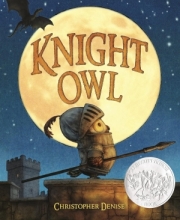
Knight Owl
From the moment he hatched, Owl’s wish was to become a knight. Through digital illustrations, often in full-page spreads, readers can perch on the castle wall with Owl as he begins his watch, and comes face to face with a dangerous, hungry dragon. Clever Owl keeps his wits about him and convinces the dragon that he is way too small to satisfy his hunger, and tempts him instead with a pizza! The unlikely friends realize they have quite a bit in common and are able to keep the peace. This Caldecott Honor book’s illustrative glow, endearing main character, and creative play on words make this book a real hoot.
Tips for Using with Children
At the end of the story, revisit Owl's early imaginings. Reflect on whether Owl achieved his aspiration of becoming a real knight and how he demonstrated his bravery and cleverness. Note the subtle hints within the illustrations like the newspaper headlines, Squires pizza advertisements on the wall, and the presence of knights of the round table with pizza. Discuss what sets Owl apart from the other knights and what he has in common with the dragon. What type of friends did Owl envision and what friends did Owl ultimately gain? Finally, ask children to share their own dreams for the future.
Tips for Using with Families
Adults can talk with children about the characteristics of owls prior to reading the story. Since owls typically sleep during the day and are awake at night, that would make owls very good candidates for standing guard during the night shift. Owl was small, but worked hard and was brave and clever when it came to solving problems. When reading the book for the first time, adults can pause when the dragon appears and ask children to predict what they think will happen. Point out the shadow on the side of the castle and ask who is behind Owl.
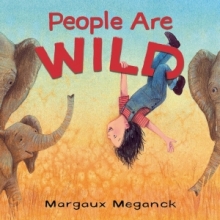
People Are Wild
In this story, a shift in perspective offers readers a unique glimpse into the world of animal families and their observations of creatures in the wild. Curiosity and interest build for readers as they listen to how humans are perceived when they enter an animal’s habitat. Humans are observed being messy, noisy, and sometimes smelly, but also cuddly and funny. Despite the differences between animals and humans, similar characteristics are shared as well, and mother elephant wisely shares that ultimately, all wild creatures should be free. A wealth of facts about each featured animal are included at the end of the book, expanding on behaviors, diets, and habitats. Additionally, a world map illustrates the geographical locations of Northern Fur Seals, Gray Bats, Milkweed Tussock Moths, and others, along with their vulnerability status to becoming endangered. This book may become one that is read and re-read many times. Now wouldn’t that be wild?
Tips for Using with Children
After reading each line in the story, ask the children to describe the picture, or how they would respond to the question being asked. For example, how are the people being loud, messy, smelly, or strange? Asking these kinds of questions will promote children’s active listening, and help them see likenesses and differences between human and animal behaviors.
Tips for Using with Families
Talk with parents about extending the theme in this simple book into their children’s everyday lives. When we meet up with wild animals in our own surroundings, sometimes they intrude upon our lives (groundhogs and rabbits eat our garden vegetables!) and sometimes we intrude upon their lives (investigating bird’s nests too closely). Brainstorm about situations in which we can teach our children to live respectfully and reasonably with the wild animals in our environments. For example, scarecrows are used to warn birds to stay away from gardens.
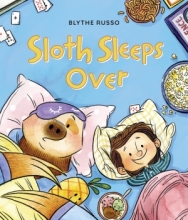
Sloth Sleeps Over
Sloth could not be more excited to be invited to her very first sleepover at her human friend Paloma’s house. She knows it will be successful because sloths love to sleep. To Sloth’s surprise, however, she quickly realizes that Paloma plans to stay up all night. After an evening of pizza, ice cream, games, nail painting, and a spontaneous dance party, Sloth decides she must gather her nerve and be honest with her friend about how tired she is. With heavy eyelids, she is ready to tell Paloma… and finds her friend asleep! Readers who are looking for a book that has a sweet story of friendship, expressive characters, and vibrant watercolor illustrations will be excited to see that this book definitely doze. Does!
Tips for Using with Children
Reading can be a favorite part of a child’s routine, whether at bedtime at home, or during a quiet part of their classroom daily routine. Adults can create a cozy space, just like Sloth and Paloma did, that can be used for reading. Parts of the story can be built into other transition times during the daily routine as well. For example, children can pretend they are Sloth and move slowly from place to place, or turn down the lights and snuggle in at bedtime or naptime. During active parts of the day, plan a spontaneous dance party, where children can choose to alternate dancing like Paloma, or slowly and smoothly like Sloth.
Tips for Using with Families
Explaining the characteristics of sloths will help children understand why Sloth is so excited for the sleepover initially and why it becomes challenging once she is there. Adults can talk with children about sloth facts, including how they move slowly, love to swim, cannot see in bright light, and sleep upside down. So, do you think a sloth would like a sleepover? Pause during the story to ask children to look closely at each character’s facial expressions. Can they guess how they might be feeling during each activity?
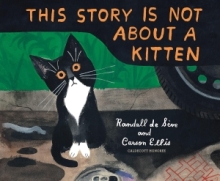
This Story is Not About a Kitten
Caldecott Honoree Carson Ellis aligns colorful, expressive illustrations with Randall de Séve’s gentle, repetitive verse to draw the reader into a story of compassion, connection, and community. Members of a community each play an important role in coaxing a scared, hungry, and lonely kitten from a hiding place into a welcoming home. Throughout the actions of each character, a thread of shared purpose connects them all and demonstrates for young readers that there are many ways to become a helper, and every role is important, no matter how small it may seem.
Tips for Using with Children
After reading the story, look back at the illustrations together. All the characters appear in the kitten’s new home at the end of the story. Can children recall how each of the characters helped? Build on the concept of classroom community by adding stuffed animals and props such as boxes, bowls, and veterinary kits to the play area so that children can work together to care for animals in need.
Tips for Using with Families
This story uses repetition and rhythm, and adults may find it helpful to preview the book ahead of time to get comfortable with the cadence of the text. During the preview, note how the illustrations support the text. Reading slowly, allowing children to notice what is happening with each new page. This will provide children time to take in all the details on each page, and as they notice the repeated parts of the story, adults can pause so that children can fill in repeated words. Adults can also talk to children about the title of the story, and after reading, talk about the way everyone in the story came together to help the kitten. Adults can ask children to imagine that they were a character in the story. In what way might they have helped?
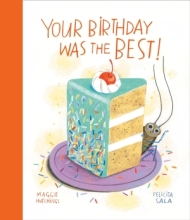
Your Birthday was the Best!
When an unexpected guest shows up at a birthday party, the guest cockroach interprets their screams as shouts of excitement. Despite the reaction of the other party guests, cockroach joins in the festivities. When Dad decides enough is enough, cockroach is transported by force to even more fun… inside a vacuum cleaner and then on to the trash bin. Worried that this departure from the party will be disappointing to the birthday star, cockroach makes its way back to avoid missing out for too long. What this outgoing and friendly cockroach does not realize is that it is not necessarily welcome, but do not worry, readers. That does not bug him!
Tips for Using with Children
Show the children the front and back of the book that has a picture of the star of the story—a cockroach. Explain that a cockroach is a kind of insect that usually has six legs, two antennae, and wings. A real cockroach is about the size of a thumbnail. Tell the children that this story is told by the cockroach, and it is the cockroach's thoughts about what is happening as the story unfolds. Ask the children if we can usually tell what a cockroach is thinking. Probably not, so the story is make-believe or fiction. Give the children an opportunity to look at the pictures as there is a great deal to see and discuss.
Tips for Using with Families
Parents may be surprised to find that a cockroach is the main character in this funny, but sometimes squeamish, birthday party story. Children will enjoy hearing this story repeatedly for the outlandish bug’s eye views of the best birthday party ever attended. Multiple readings of the same book are important as young children learn new words and phrases. What kinds of words and phrases do you think your children will find? What do you think a cockroach would find in your vacuum cleaner? Every time a child hears the same story, their memory skills improve as they chime in with the familiar story.
